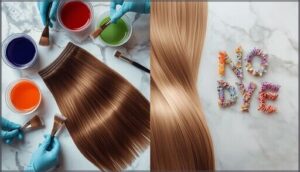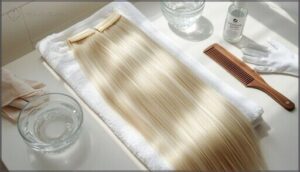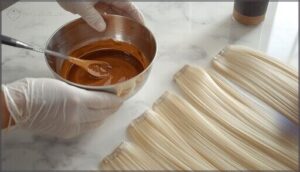This site is supported by our readers. We may earn a commission, at no cost to you, if you purchase through links.
A box of hair extensions hardly ever looks the same once you’ve lived with it for a while—colors fade, roots grow, and suddenly the shade you loved needs a little refresh. Maybe you picked up a set that’s stunning but just a shade off from your natural hair, or your style has changed and your extensions haven’t kept up.
Can you dye hair extensions and revive them to match your vision? The answer depends on a few key details most people miss, and getting the color just right means understanding how these strands handle dye—not all hair extensions play by the same rules.
Table Of Contents
Key Takeaways
- Only 100% human hair extensions, especially Remy and virgin types, can be safely and effectively dyed, while synthetic options resist color and may get damaged.
- Before dyeing, prepping extensions by clarifying, testing a strand, and gathering the right supplies is crucial for even, healthy results.
- Using low-ammonia, extension-safe dyes, gentle timing, and cool water rinses helps protect both color and hair quality.
- Proper aftercare—like sulfate-free products, low heat styling, and careful storage—keeps dyed extensions vibrant and extends their lifespan.
Can You Dye Hair Extensions?
The short answer is yes, but it depends entirely on what your extensions are made of. Human hair extensions can be dyed just like your natural hair, while synthetic ones won’t take color and can actually melt under chemical processing.
Before you grab that dye kit, you need to understand a few key factors that determine whether your extensions are good candidates for coloring.
Human Vs Synthetic Hair Extensions
When you’re looking to dye hair extensions, material composition makes all the difference. Human hair extensions accept color beautifully because they’ve dye absorption capabilities just like your natural hair, offering styling versatility you can’t get elsewhere. Synthetic hair extensions resist traditional dyes entirely due to their fiber structure.
While synthetic options cost less upfront, human hair extensions deliver longer lifespan differences, lasting 6-12 months versus synthetic’s brief 2-3 weeks. The salon industry expansion is also creating more opportunities for hair extension services.
Factors That Affect Dyeing Success
Your extensions’ porosity determines how quickly they’ll soak up color—high porosity means faster, darker results. Cuticle integrity matters too, since damaged cuticles lead to patchy color and quicker fading. Even hair quality and hydration affect color absorption, so understanding these factors helps you avoid disappointment.
The dye type you choose, processing time you follow, and moisture levels before you start all shape your final outcome. Considering hair’s porosity levels is key for achieving predictable color results.
Risks and Limitations of Dyeing Extensions
While porosity and technique matter, you’re also facing real downsides when dyeing extensions. Chemical exposure from harsh dyes can trigger allergic reactions like scalp blistering or dermatitis, and physical damage—dryness, hair breakage, split ends—happens fast with over-processing.
Limitations include:
- Synthetic hair extensions resist color customization and may melt
- Bleach extensions risks weakening cuticles and causing irreversible hair damage
- Regulatory concerns around banned ingredients like lead
- Preventing hair damage requires careful product selection and testing
Which Hair Extensions Can Be Safely Dyed?
Not all hair extensions are created equal for dyeing. The material your extensions are made from determines whether you can safely color them, and how well they’ll hold up to the process.
Let’s break down which types you can confidently dye and which ones you should leave as-is.
100% Human Hair Extensions
If you’re wondering, “Can you dye hair extensions just like your own hair?”—the answer is yes, if they’re made from 100% human hair.
Coloring human hair extensions is possible using salon-grade dyes, but be mindful: every round of color, even gentle dyeing, chips away at the cuticle layer and impacts the lifespan after dye. Results may vary due to color consistency risks.
Remy and Virgin Hair Extensions
When you want vibrant results, Remy human hair reigns for dyeing hair extensions. Thanks to its aligned cuticles, color glides on smoothly, and Remy Dyeability minimizes patchiness. Virgin Resilience means fewer processing worries; untouched, its strength resists color damage.
Remy human hair extensions dye evenly and resist damage, delivering vivid color and smoother results than other types
Still, solid color retention and healthy hair depend on regular conditioning and gentle routines. Statistics show proper maintenance doubles extension life after coloring human hair extensions.
Synthetic Extensions and Dyeing Challenges
Fiber composition is the big challenge: synthetic extensions are built from plastics, not hair, so standard dye won’t stick. Even if you try dyeing hair extensions with fabric dye, color durability is weak—expect serious fade by wash five. Physical damage is common, from fraying to melting, plus health concerns with chemical residues make “DIY coloring” risky.
- Most dyes don’t penetrate synthetic hair
- Fast color fade is virtually guaranteed
- Aggressive chemicals damage the fiber easily
- Some components may irritate sensitive scalps
Identifying Extension Type Before Dyeing
A close look and a couple of simple tests can save you heartache down the line. Use Visual Texture checks—real human hair extensions feel slightly rough, never slick. For Water Absorption, genuine hair sinks and soaks up water, while synthetic floats. Cuticle Analysis and Detergent Tests also help—authentic extensions show strand irregularities.
Dyeing hair extensions safely starts by knowing exactly what you’re working with.
How to Prepare Hair Extensions for Dyeing
Before you reach for the dye, taking a few careful steps will set you up for success. Preparation makes all the difference in how your extensions take color and hold up afterward.
Here’s what you need to know before you get started.
Pre-Washing and Removing Product Buildup
Think of product buildup as a shield that locks dye out. Before coloring, you should always use a clarifying or sulfate-free shampoo, prepping clean, tangle-free extensions.
- Wash with a clarifying shampoo for stubborn residue.
- Gently detangle using a wide-tooth comb.
- Opt for a natural rinse like diluted apple cider vinegar.
- Let extensions air dry, never use heat.
Performing a Strand Test
Ever heard the saying “test before you invest”? That’s the core of a strand test. By dyeing a small, hidden section first, you spot Color Compatibility issues and confirm Timing Accuracy.
This step is key for Damage Prevention, especially when dyeing hair extensions. Synthetic Results can be patchy, so assess, then tweak your Formula Adjustments before going all-in.
Gathering Tools and Supplies
Before you dye hair extensions, don’t underestimate sharp preparation. Reliable tools safeguard your results and sanity. Grab a plastic mixing bowl and dense brush for even color, then choose protective glove options that match your comfort. Add sturdy sectioning clip styles, a squeeze of sulfate-free shampoos, and accurate timing devices.
- Mixing bowl types
- Protective glove options
- Sectioning clip styles
Choosing The Right Hair Dye
After you’ve gathered your supplies, picking the best hair dye becomes most important. Focus on ammonia levels; stick with low-ammonia, semi-permanent dye types for healthy strands and steady color longevity.
Not every brand makes the cut—extension-safe lines like Arctic Fox and Wella nail chemical compatibility.
Matching your hair shade? Always double-check for blendability when choosing hair dye color or shades.
Step-by-Step Guide to Dyeing Hair Extensions
Ready to give your extensions a new look? Here’s a straightforward walkthrough to help you get great results and keep your hair healthy. Let’s break down the process into clear steps.
Mixing and Applying The Dye
Before you start applying hair dye to extensions, mix your dye and developer in a 1:2 ratio in a non-metallic bowl, stirring until smooth.
Sectioning techniques matter—part hair into small, flat pieces for thorough coverage. Work dye down each strand with a tint brush, using gentle, even strokes.
Avoid over-saturation or missing spots to guarantee great results in your dyeing process.
Timing and Processing Color
While applying hair dye to extensions, set a timer—the right window for dye processing time matters more than you’d think. For human hair, check color development every 5–10 minutes, aiming for 20–40 minutes overall. With synthetics, limit to 10–15.
Here’s what keeps color on point:
- Use timers faithfully
- Monitor color closely
- Never over-process
Rinsing and Conditioning Extensions
Once color sets, let Water Temperature work for you—rinse extensions with cool water until it runs clear. Follow up with a sulfate-free, color-safe conditioner to seal the cuticle. Deep conditioning weekly keeps colored hair vibrant and hydrated. Caring for colored hair extensions means rinsing gently, using effective products, and spacing washes to preserve both tone and health.
| Water Temperature | Product Efficacy | Rinsing Frequency |
|---|---|---|
| Cool/Lukewarm | Sulfate-Free Conditioner | Every 2–3 Days |
| Hot (avoid) | Color-Safe Conditioner | After 30 Wears |
| Distilled (best) | Deep Conditioning Mask | Weekly |
| Tap (risk buildup) | Leave-in Conditioner | As Needed |
| Hard (dehydrates) | Hydration Methods: Oils | Minimize for Strength |
Drying and Styling Techniques
Once you’ve rinsed your extensions, air-drying is your friend—this preserves texture and limits heat damage. If you need to speed things up, stick to blow-drying with a cool-to-warm setting, always using a heat protectant.
Brush gently with a wide-tooth comb once nearly dry, and keep product usage light to maintain smooth, vibrant hair extension styling results.
Caring for Dyed Hair Extensions
Once your hair extensions have a fresh new color, keeping them healthy and vibrant does take some extra care.
How you treat dyed extensions makes all the difference in how long they look their best. Here’s what to focus on after the color process.
Using Sulfate-Free and Moisturizing Products
Ever wondered why so many extension wearers swear by sulfate-free shampoo and conditioner? It’s all about moisture retention and color protection. Sulfate-free benefits include less color fade, better hair moisture, and noticeable damage prevention.
Add weekly moisturizing masks for hair hydration, and you’ll see serious longevity maintenance––your extensions keep their shine, softness, and vibrancy longer without feeling dry or brittle.
Minimizing Heat and Preventing Damage
While heat can make your dyed extensions shine, too much of it’s a recipe for regret. Prioritize protection with these habits:
- Always apply heat-protecting spray before using hot tools.
- Keep temperature control below 150°C (300°F) to maintain hair integrity.
- Limit styling frequency—once a week is plenty when protecting hair extensions from damage during safely dyeing hair extensions.
Preventing Color Fade and Maintaining Vibrancy
Think of hair color like a delicate fabric: over-washing, hot water, or skipping a color-safe shampoo bleeds out vibrancy fast.
Rinse in cool water, use a UV protection spray before sun exposure, and deep-condition weekly.
For the best results, schedule professional maintenance touch-ups—these habits keep color fade at bay and turn hair extension maintenance into true hair color maintenance.
Storage and Ongoing Maintenance Tips
Proper storage is where smart hair extension care starts—think silk bags, dry rooms, and no sunlight to dodge frizz and tangling.
Wash and condition before storing, let air fully dry, and give weekly gentle brushing.
These cleaning methods and regular inspection keep maintenance frequency—and costs—low, protecting your investment and extending the life of every dyed extension in your collection.
Frequently Asked Questions (FAQs)
How often can dyed extensions be recolored safely?
Safe recoloring intervals for dyed hair extensions are every 4–6 weeks, though extension type and damage rates matter. Professional outcomes are better, as overprocessing shrinks lifespan and increases wear.
Avoid frequent hair dye sessions for best hair extension maintenance.
Can hair extensions be bleached to a lighter shade?
If you’ve wondered about bleach and hair lightening, only human hair extensions can be safely bleached—barely.
Most pros recommend against it due to bleaching damage risks; synthetic bleach alternatives are your best bet for dyeing hair extensions safely.
Are colored hair extensions safe for sensitive scalps?
Colored hair extensions can be safe for sensitive scalps, but allergy risks from chemical irritants, microbial concerns, and attachment methods remain.
Check for hypoallergenic or plant-based hair dye, and boost consumer awareness around safe coloring methods.
Will dyeing extensions affect their natural texture?
Expect dyeing hair extensions to bring texture change—frizz and roughness go up, curl pattern loss is common, and poor dye quality only worsens things.
Synthetic fiber damage is almost guaranteed; human hair extensions’ porosity increases, leaving them more fragile.
Do colored extensions require special styling products?
You’ll get the best results from hair extensions by using color-safe shampoo and conditioner, sulfate-free products, heat protection sprays, and moisturizing formulas.
These keep color vibrant, prevent product buildup, and lock in much-needed hydration for smoother styling.
Conclusion
Imagine watching sunlight hit a fresh canvas—colors shift, new tones emerge, and something familiar transforms right before your eyes. That’s the magic waiting when you investigate the truth behind “can you dye hair extensions.”
With a steady hand and careful technique, extensions become more than just an accessory: they’re a perfect fit for your style and energy. Every strand holds the potential for renewal, and you, brush in hand, control how vivid your finish truly becomes.
- https://thelaurenashtyncollection.com/blogs/blog/coloring-hair-extensions
- https://prolongedhair.com/blogs/hair-prolonged/the-risks-of-textile-dyes-in-hair-extensions-and-safer-alternatives
- https://theconversation.com/your-wig-could-be-poisoning-you-study-finds-pesticides-and-other-toxic-chemicals-in-synthetic-hair-in-nigeria-231457
- https://www.meticulousresearch.com/product/hair-extension-market-5871
- https://www.gyantihair.com/blog/35/the-growing-demand-for-colored-human-hair-extensions.htm











